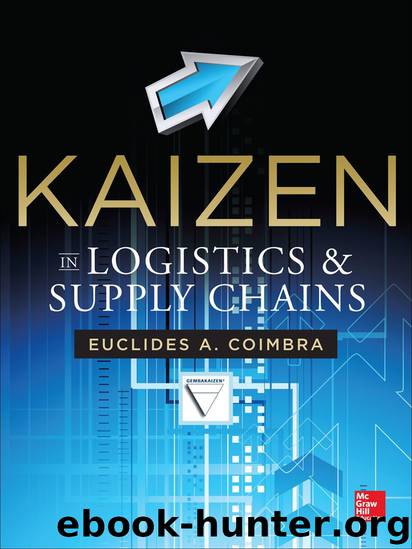Kaizen in Logistics and Supply Chains by Coimbra Euclides

Author:Coimbra, Euclides [Coimbra, Euclides]
Language: eng
Format: epub
Publisher: McGraw-Hill Professional
Published: 2013-04-27T00:00:00+00:00
Example 2
Another interesting example of applying the TFM model involved organizing flow in the supply of a car assembly line. Car assembly lines involve thousands of components. The size and variety of parts they handle make them far more complex than the preceding electronics example. In a car assembly line, there are very small parts, such as screws, together with big parts, such as bumpers. The variety is created by the potential options in the models and colors of the cars. Just to supply the bumpers is paradigmatic, in the sense that their color must match the body color, and the number of options is so varied that the only possible method for line supply is junjo (“sequence”).
In these lines, you can have all the various types of borders of line, namely:
Kanban front supply (in subassemblies)
Kanban rear supply
Junjo front supply (in subassemblies)
Junjo rear supply
Junjo kit supply
In terms of mizusumashi lines, the usual ones for this situation include
A train of wagons with shelves supplying small and medium plastic containers with 60-minute-cycle inside kanban loops
A train of wagons with pallets on wheels supplying big containers with 20-minute-cycle inside kanban loops
A train of wagons with wheeled bases with special fixtures supplying parts with variable-cycle inside junjo loops
AGVs to transport kit containers from picking supermarkets
The types of supermarkets seen in car assembly flow plants include
Flow racks (also called kanban racks) for small and medium-sized plastic containers and pallets of plastic containers
Big containers on wheeled bases at ground level
Special trolleys with junjo parts
Originally, Toyota flow assembly lines were organized mostly using the kanban type of border of line and all the necessary supply logistics. Since the early 1990s, the company has evolved to the junjo type, with kitting border of lines. As the range of options and models increases, the size of the kanban borders of line has to increase with it. This begins to hurt productivity, so the junjo form of supply becomes an attractive solution.
A Toyota press release issued in 2006 said:
Toyota Motor Corporation has introduced a new material-handling system based on kitting to reduce complexity and improve quality in assembly areas. A spokesman for Toyota Motor North America said the kitting system was being introduced on “more and more lines” at the Georgetown facility and elsewhere in North America. He said it was “not a complete sea change” in parts presentation and wasn’t applicable to all production areas.
At Georgetown, the correct parts for a particular Camry or Avalon are selected into a tray that is placed inside the car as it heads down the line. Because part selection is done upstream, assemblers can “focus on the quality of installation,” according to the Toyota spokesman. Variety and the resulting complexity have proliferated as more and more features are offered to customers. For instance, before the new system was introduced for the current generation Camry and Avalon, team members had to choose between 24 varieties of sun visors.
The switch also eliminates reaching, stretching, and searching for parts by assembly operators. The new arrangement also makes training operators and material handlers easier because the job responsibilities are narrower.
Download
This site does not store any files on its server. We only index and link to content provided by other sites. Please contact the content providers to delete copyright contents if any and email us, we'll remove relevant links or contents immediately.
Whiskies Galore by Ian Buxton(41937)
Introduction to Aircraft Design (Cambridge Aerospace Series) by John P. Fielding(33091)
Small Unmanned Fixed-wing Aircraft Design by Andrew J. Keane Andras Sobester James P. Scanlan & András Sóbester & James P. Scanlan(32763)
Craft Beer for the Homebrewer by Michael Agnew(18194)
Turbulence by E. J. Noyes(7977)
The Complete Stick Figure Physics Tutorials by Allen Sarah(7336)
Kaplan MCAT General Chemistry Review by Kaplan(6899)
The Thirst by Nesbo Jo(6877)
Bad Blood by John Carreyrou(6581)
Modelling of Convective Heat and Mass Transfer in Rotating Flows by Igor V. Shevchuk(6406)
Learning SQL by Alan Beaulieu(6237)
Weapons of Math Destruction by Cathy O'Neil(6213)
Man-made Catastrophes and Risk Information Concealment by Dmitry Chernov & Didier Sornette(5951)
Digital Minimalism by Cal Newport;(5701)
Life 3.0: Being Human in the Age of Artificial Intelligence by Tegmark Max(5509)
iGen by Jean M. Twenge(5384)
Secrets of Antigravity Propulsion: Tesla, UFOs, and Classified Aerospace Technology by Ph.D. Paul A. Laviolette(5332)
Design of Trajectory Optimization Approach for Space Maneuver Vehicle Skip Entry Problems by Runqi Chai & Al Savvaris & Antonios Tsourdos & Senchun Chai(5037)
Pale Blue Dot by Carl Sagan(4952)
